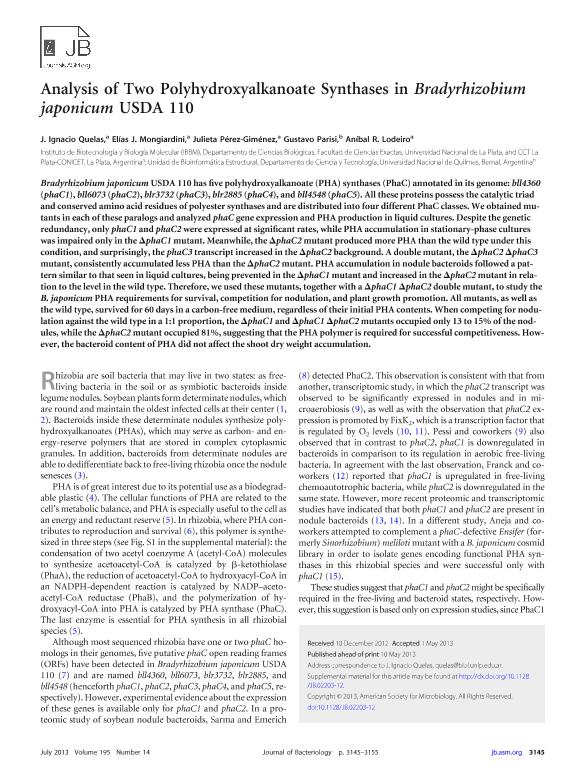Artículo
Analysis of Two Polyhydroxyalkanoate Synthases in Bradyrhizobium japonicum USDA 110
Quelas, Juan Ignacio ; Mongiardini, Elias Javier
; Mongiardini, Elias Javier ; Pérez Giménez, Julieta
; Pérez Giménez, Julieta ; Parisi, Gustavo Daniel
; Parisi, Gustavo Daniel ; Lodeiro, Anibal
; Lodeiro, Anibal
 ; Mongiardini, Elias Javier
; Mongiardini, Elias Javier ; Pérez Giménez, Julieta
; Pérez Giménez, Julieta ; Parisi, Gustavo Daniel
; Parisi, Gustavo Daniel ; Lodeiro, Anibal
; Lodeiro, Anibal
Fecha de publicación:
07/2013
Editorial:
American Society for Microbiology
Revista:
Journal Of Bacteriology
ISSN:
0021-9193
Idioma:
Inglés
Tipo de recurso:
Artículo publicado
Clasificación temática:
Resumen
Bradyrhizobium japonicum USDA 110 has five polyhydroxyalkanoate (PHA) synthases (PhaC) annotated in its genome: bll4360 (phaC1), bll6073 (phaC2), blr3732 (phaC3), blr2885 (phaC4), and bll4548 (phaC5). All these proteins possess the catalytic triad and conserved amino acid residues of polyester synthases and are distributed into four different PhaC classes. We obtained mutants in each of these paralogs and analyzed phaC gene expression and PHA production in liquid cultures. Despite the genetic redundancy, only phaC1 and phaC2 were expressed at significant rates, while PHA accumulation in stationary-phase cultures was impaired only in the phaC1 mutant. Meanwhile, the phaC2 mutant produced more PHA than the wild type under this condition, and surprisingly, the phaC3 transcript increased in the phaC2 background. A double mutant, the phaC2 phaC3 mutant, consistently accumulated less PHA than the phaC2 mutant. PHA accumulation in nodule bacteroids followed a pattern similar to that seen in liquid cultures, being prevented in the phaC1 mutant and increased in the phaC2 mutant in relation to the level in the wild type. Therefore, we used these mutants, together with a phaC1 phaC2 double mutant, to study the B. japonicum PHA requirements for survival, competition for nodulation, and plant growth promotion. All mutants, as well as the wild type, survived for 60 days in a carbon-free medium, regardless of their initial PHA contents. When competing for nodulation against the wild type in a 1:1 proportion, the phaC1 and phaC1 phaC2 mutants occupied only 13 to 15% of the nodules, while the phaC2 mutant occupied 81%, suggesting that the PHA polymer is required for successful competitiveness. However, the bacteroid content of PHA did not affect the shoot dry weight accumulation.
Palabras clave:
Polyhydroxyalkanoate Synthases
,
Bradyrhizobium Japonicum
,
Phac1
,
Phac2
Archivos asociados
Licencia
Identificadores
Colecciones
Articulos(IBBM)
Articulos de INST.DE BIOTECNOLOGIA Y BIOLOGIA MOLECULAR
Articulos de INST.DE BIOTECNOLOGIA Y BIOLOGIA MOLECULAR
Articulos(SEDE CENTRAL)
Articulos de SEDE CENTRAL
Articulos de SEDE CENTRAL
Citación
Quelas, Juan Ignacio; Mongiardini, Elias Javier; Pérez Giménez, Julieta; Parisi, Gustavo Daniel; Lodeiro, Anibal; Analysis of Two Polyhydroxyalkanoate Synthases in Bradyrhizobium japonicum USDA 110; American Society for Microbiology; Journal Of Bacteriology; 195; 14; 7-2013; 3145-3155
Compartir
Altmétricas



